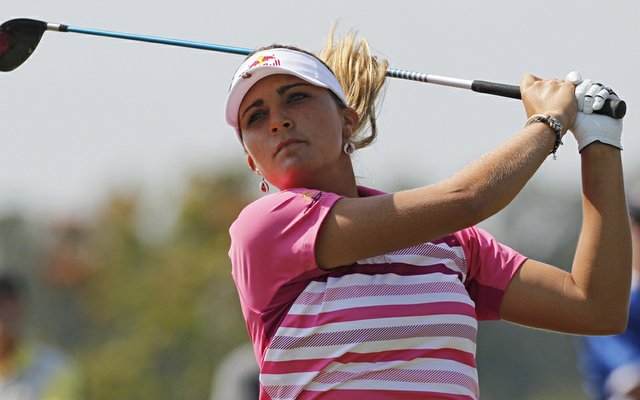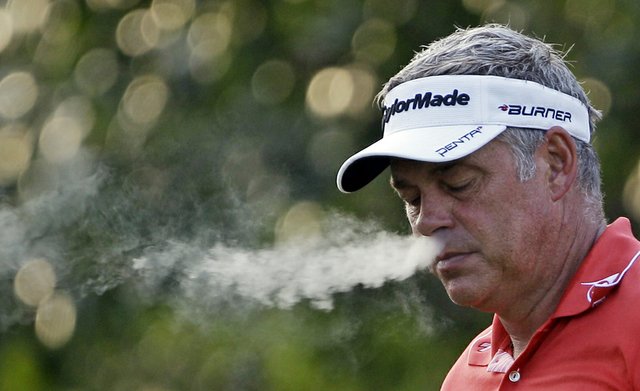Your Move Commish: Lexi WD's From Q-School
/ Sean Martin talks to Lexi Thompson'a agent, who confirms the 16-year-old winner of an LPGA event will not be returning to Q-School next week, whapping the ball firmly in Commissioner Mike Whan's court.
Sean Martin talks to Lexi Thompson'a agent, who confirms the 16-year-old winner of an LPGA event will not be returning to Q-School next week, whapping the ball firmly in Commissioner Mike Whan's court.When you come to think of it that is the secret of most of the great holes all over the world. They all have some kind of a twist. C.B. MACDONALD

 Sean Martin talks to Lexi Thompson'a agent, who confirms the 16-year-old winner of an LPGA event will not be returning to Q-School next week, whapping the ball firmly in Commissioner Mike Whan's court.
Sean Martin talks to Lexi Thompson'a agent, who confirms the 16-year-old winner of an LPGA event will not be returning to Q-School next week, whapping the ball firmly in Commissioner Mike Whan's court.You had to think all of these years flying on Air Tim I or II would have led to more aeronautical metaphors, but today's was the first I've come across in several years of agonizing through Tim Finchem press conference transcripts.
From East Lake and sandwiched in between some awards announcements:
About this year, I think it's been a kind of long, grueling year from the standpoint of workload. It's been a tremendously rewarding year from the standpoint of first watching so many good young players succeed and positioning the Tour for the next ten years. And as I said a couple weeks ago in Boston, we're delighted with our new television agreements. It really gives us a long runway.
Yes, it is indeed a long runway. You could take off, land and take off (again) in your Citation on this runway.
These next comments on parity were the primary takeaway remarks for wire stories in search of deep meaning from today's presser.
And then the other thing I'd say about the competition, and I don't know exactly how to articulate this, but clearly we've gone very quickly from a point in time when we were very much a sport that was -- had a dominant player to all the way to the other end of the spectrum, not part way, but all the way to the other end of the spectrum. We had a player on the Player Advisory Council on some issue we were talking about in New York saying we're at a point of total parity. Anybody out here can win any given time. And it occurred to me that that's true, and so far the fans seem to really like it, and it'll be interesting to see what develops in that regard going forward.
Key words: so far.
Our ratings are up this year as a result of that interest, and I think that interest triggered a lot of what was very positive in our television negotiations. On both fronts, television and the caliber of our competition, we're very, very pleased as we come to the end of the FedExCup.
That's because they hit rock bottom last year!
Alright, strap in, here comes the FedExCup pitch.
Then toward the end of the -- just before the Playoffs, we had a really good upsurge in the quality of the field at Wyndham with Harrington and Els and others playing, which is another indicative of how strongly players feel about the importance of the Playoffs in and of themselves and the FedExCup overall.
You know, if you go back in golf and look at any tournament, go back to Tom Morris, however far you want to go back, there is a graduation of stature of any event that rides with the extent to which players prioritize that event.
Whoa there. Did Old Tom Morris just get lumped into a FedExCup/quality of field discussion? Did he ever play the Wyndham to enhance his chances of making it to Cog Hill before the second reshuffle?
And then perhaps most importantly is measuring and recognizing the reaction of the fans to what the FedExCup is. We've had an increase in overall awareness every year, our attendance, our overall gross attendance has been up with one exception the last three years. We attribute the fact that our overall ratings are up this year to the fact that, especially in an era of parity, perhaps, fans are more interested in figuring out who these guys are, spending more time with the telecast and watching them proceed through the FedExCup competition. And so the number of minutes on average that our fans spend with the telecast this year was up nicely.
Or maybe it's just been hot and rainy outside?
Nice adjustment here by the transcript editors. Cume looks so much better than the old transcript spelling:
In addition, our overall cume viewership, 84 million Americans watched us more than ten weeks, 146 million Americans have watched us some. We continue to be on just an event to event basis second only to the NFL in terms of the total audience that's with us in a particular event up against any other sport on average. These are all trends that are really important to the health of our sponsorship, but they emanate from the interest that the fans have.
They just can't get enough of the algorithms?
He did leave a bit of an opening for a change to the end of the FedExCup, with the groundwork laid to blame television for a tweak to have the final days (or day) as a true playoff:
But I do think there's an argument for continuity and letting people settle in with what's happening. It's particularly -- it's a challenge for television to cover when you have two different competitions going on, particularly like last year here where you had a lot of different stories, and the first three weeks in the Playoffs you've got a lot of different stories with the cut line, and then you've got stories at the top. I think it's great television, and I think our partners are doing a really good job. It's a challenge, but I think they've really stepped up and really hit on it now, and I think it's captivating for our fans, and it's good.
 Alex Miceli reports that the World Anti-Doping Agency has taken the first steps toward classifying nicotine as a performance-enhancing drug.
Alex Miceli reports that the World Anti-Doping Agency has taken the first steps toward classifying nicotine as a performance-enhancing drug. Rene Stutzman of the Orlando Sentinel shares the bizarre story of a golf management company--behind in its payments--suing the city of Sanford, owners of Mayfield Country Club, claiming the city has lied about the design heritage of the course.
Rene Stutzman of the Orlando Sentinel shares the bizarre story of a golf management company--behind in its payments--suing the city of Sanford, owners of Mayfield Country Club, claiming the city has lied about the design heritage of the course.Teddy Greenstein coralled Johnny Miller before he hopped in his Town Car for a few quotes about the Cog Hill criticism from players.
Sally Jenkins pens a must-read column (thanks reader John) on the state of American golf and tennis player development and opens with a nice play on one of her old man's great lines: "There’s nothing wrong with American tennis and golf that a double-dip recession can’t cure."
This, I've heard from a few college golf coaches and credit Stanford's Conrad Ray for having the guts to say what so many other would like to say:
When I asked Stanford University golf Coach Conrad Ray why international players are winning majors while young Americans are not, he suggested I check out the Web site for the Sage Valley Invitational. It’s the most prominent tournament for juniors in America, and it’s a lovely event — maybe too lovely. It’s held on a beautifully groomed course designed by Tom Fazio.
This year’s field of 54, who ranged in age from 14 to 18 and included 15 foreigners, got personalized lockers in the clubhouse, and top caddies to carry clubs and tend their pins. The sponsor Electrolux paid for all of their travel and expenses, and they were showcased by CBS in a taped hour-long broadcast. The winner’s trophy and blazer were presented by PGA Tour Commissioner Tim Finchem.
Basically, they were treated like they had already arrived.
“It’s amazing to see how much they are given, and what the experience is at a young age,” Ray says. “If you go down that road, that’s what you start to expect, and want.”
And the home run point by Jenkins, which would seem to support the cause of those who believe initiatives like The First Tee are far less helpful in young people's lives than better access to actual golf courses and self-taught talent:
Think about it. The golden age of American tennis in the 1970s was dominated by self-styled champions who learned to play in town parks: Arthur Ashe, son of a public park policeman; Billie Jean King, fireman’s daughter and a public park champion; Chris Evert, daughter of a teaching pro from a public park; Jimmy Connors, son of a toll booth attendant, taught by his mother in a back yard.
The golden age of American golf in the 1930s and ’40s was dominated by bitterly poor kids who were self-schooled: Ben Hogan, son of a widowed seamstress, who never finished high school and delivered newspapers to support himself; Byron Nelson, another poor dropout who snuck on to the Glen Garden Country Club course at night to practice in the dark; Sam Snead, still another self-taught caddie, who went to work at the age of seven.
For some reason, lately we’ve been telling kids in this country that golf and tennis are hard to teach, and expensive to learn. They aren’t. What we should be telling them is that it doesn’t cost a dime to imagine greatness, and they don’t need many tools to invent themselves. All they need is the ground under their feet, and some sticks.
 As rivetting as it was to learn from Jimmy Roberts that Camilo Villegas banged his fist on a table upon learning his rejection by the ShotLink algorithms at Sunday's BMW Championship, it turns out that the Presidents Cup points battles on both sides made for far more compelling reading.
As rivetting as it was to learn from Jimmy Roberts that Camilo Villegas banged his fist on a table upon learning his rejection by the ShotLink algorithms at Sunday's BMW Championship, it turns out that the Presidents Cup points battles on both sides made for far more compelling reading. Stuart McKinley reports on what I thought was nothing more than harmless Twitter banter between juveniles in the Chubby stable. It all started when Rory sided with the European team in the Seve Trophy. Just the kind of thing that starts wars over there.
Stuart McKinley reports on what I thought was nothing more than harmless Twitter banter between juveniles in the Chubby stable. It all started when Rory sided with the European team in the Seve Trophy. Just the kind of thing that starts wars over there.Geoff Shackelford is a Senior Writer for Golfweek magazine, a weekly contributor to Golf Channel's Morning


Copyright © 2022, Geoff Shackelford. All rights reserved.